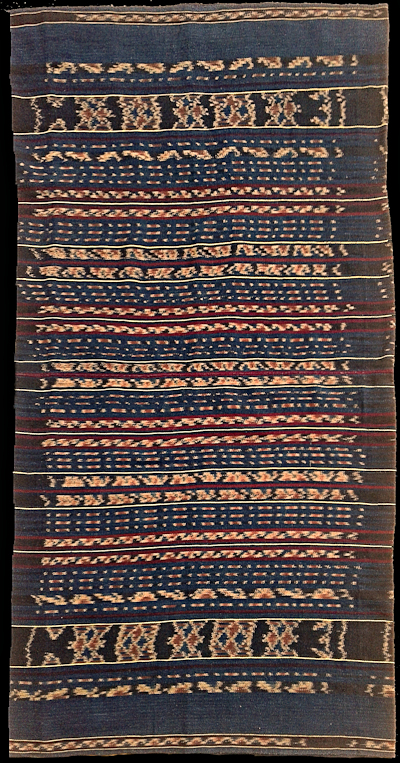| |
 

LEFT THE COLLECTION
display continued to support resarch | | | |
352 Sumba, East Sumba
Hinggi (men's blanket)
| | | Period: | Late 19th-early 20th century | | Yarn: | Cotton, hand-spun, medium | | Technique: | Warp ikat | | Panels: | 2 | | Design: | Design with hidden asymmetry, created by minute devices placed in the centreband, the kundu duku (see Macro): four red crosses that do not have a counterpart on the other side of the cloth's horizontal axis. The kundu duku is decorated with the patola-inspired patola ratu motif - which, because of its complexity is very handy for hiding keys that produce asymmetry and are easy to overlook - and indeed very hard to find even when you are aware that they may be there, because the dyers of such cloth knew how we process visual information. Our tendency to generalize causes us to overlook small deviations from expected regularity - Gombrich's 'etc. principle'. The cloth has a classic nine band field division, with deer in the widest bands, horses and milkweed plants in the second widest, and birds in the third widest. All of the motifs except the milkweed, wanggakoli, are reserved for the nobility. The birds likely represent cockatoos a (non-exclusive) hallmark of the court of Rende. | | Comment: | [PHOTOGRAPHY PROVISIONAL] | | Background: | Chapters on Sumba and East Sumba. | | Sources: | This type of hidden asymmetry is the subject of Peter ten Hoopen's Noble Virtuosity: Hidden Assymmetry in Ikat from Sumba (2025)' published by Museum and Art Galllery, The University of Hong Kong'. The design of this specimen is similar to that of one in the Asian Civilisations Museum, Acc. nr. 1997-04228 and contains largely the same decorative elements. | | |

©Peter ten Hoopen, 2025
All rights reserved.
|
|


